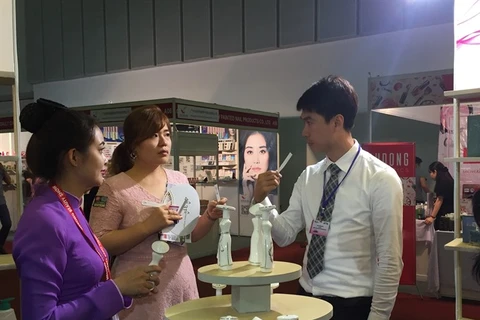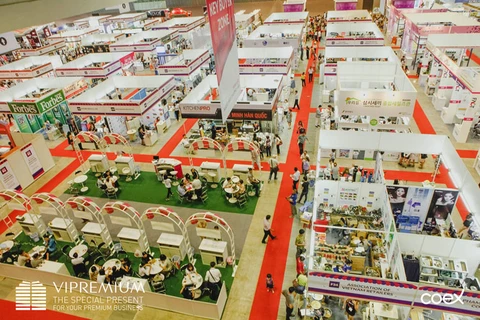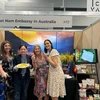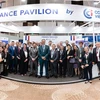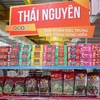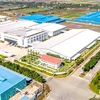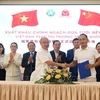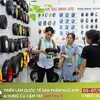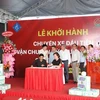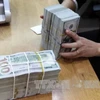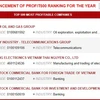 Premium products on display at a Vietnam International Premium Products Fair held in HCM City last month (Photo: VNA)
Premium products on display at a Vietnam International Premium Products Fair held in HCM City last month (Photo: VNA) HCM City (VNA) - Mollis organic towels of Phong Phu Corporation have received “very good response” in the market after being launched last year, a sign that premium products are becoming more popular in Vietnam.
Doan Anh Dao, sales and marketing manager of the Phong Phu Corporation, said the towels, which are made from 100 percent imported cotton, are strictly inspected by the Control Union from all stages, from input to output to sales and inventory.
They are priced 30-40 percent higher than that of normal cotton towels.
“Sales of the products via Con Cung shops are very good. At Co.opmart, Big C, Aeon and some Vinmart stores, more and more customers know about the products,” Dao said.
According to retailers, sales of Vinamilk organic fresh milk have also been very good since its launch despite their much higher price compared to normal products.
Realising the potential of the Vietnamese market, many foreign companies via exhibitions and fairs want to seek business partners to distribute their products in Vietnam.
For instance, Shin Je Hwan from the Republic of Korea’s Hap Chun Foods Co. Ltd, which participated in the VIPREMIUM 2018 held recently in Ho Chi Minh City, said this is the first time Hap Chun Foods has participated in the fair. The company wants to look for agents or distributing and importing companies in Vietnam.
Dao said there is great potential for organic and premium products in Vietnamese market because consumers have increasingly paid attention to products that are good for their health.
A recent survey of Nielsen showed that with significantly improved income, Vietnamese consumers are not only buying more goods, but also spending more money on premium products.
Premium products have selling prices at least 20 percent higher than other products of the same kinds in the market, according to Nielsen.
Despite the potential of the premium product market segment, the market is mainly dominated by imports, accounting for about 80 percent, according to Nguyen Phi Van, Chairwoman of the Saigon Innovation Hub’s Board of Advisors.
Products are mostly from the Asia – Pacific region such as Japan and the RoK, and from Western Europe and North America, according to Van, who is also founder and chairwoman of Retail & Franchise Asia.
The premium market in Vietnam features mainly healthcare products, beauty care products, household appliances, consumer products, and electronic products as well as services.
In the high-end market segment, Vietnamese firms find it hard to compete with foreign firms because they have not caught up with market trends, while their foreign rivals have done this very well, Van said.
“Foreign firms are very knowledgeable about design and business model innovation to suit digital consumers as well as future consumers. Due to these difficulties, in the high-end consumer segment, Vietnamese goods cannot compete with products produced by foreign manufacturers,” she said.
According to experts, Vietnamese producers of both premium and popular products do not understand world market trends and thus cannot take advantage of the trends. This is the biggest challenge for Vietnamese firms.
Domestic businesspeople have accessed an international business mindset, but the application of these mindsets into production and business operations is still slow compared to that in other countries.
Their resources are also very limited, and they struggle to protect their popular consumer products in the market. So they have not had proper investment in exploiting higher consumer segments.
Vu Kim Hanh, Chairwoman of the High Quality Vietnamese Goods Business Association, said: "Consumers like imported products from Thailand, Japan and the RoK. One of the reasons is that as incomes increase, consumers can pay more for products in general, but they also pay more attention to the value that the products bring, especially foods and beverages good for health.”
Van said: “I hope that more Vietnamese businesses will participate in the premium market segment, but it may take a long time for them to build their position in the market.”
Many experts believe that with the current situation, imported premium goods in Vietnam will continue to increase in the coming time.
Under free trade agreements, tariff duties will be reduced, and imported goods will become more competitive, causing difficulties for Vietnamese firms.
According to Van, in this situation, Vietnamese firms need to make a big change in their managerial mindset and expand cooperation, including with foreign partners to develop the market together.
Businesses should also understand mega-trends that will lead the market not only now but also in coming years to develop suitable business innovation ideas as well as capitalise on market opportunities.-VNA
VNA
